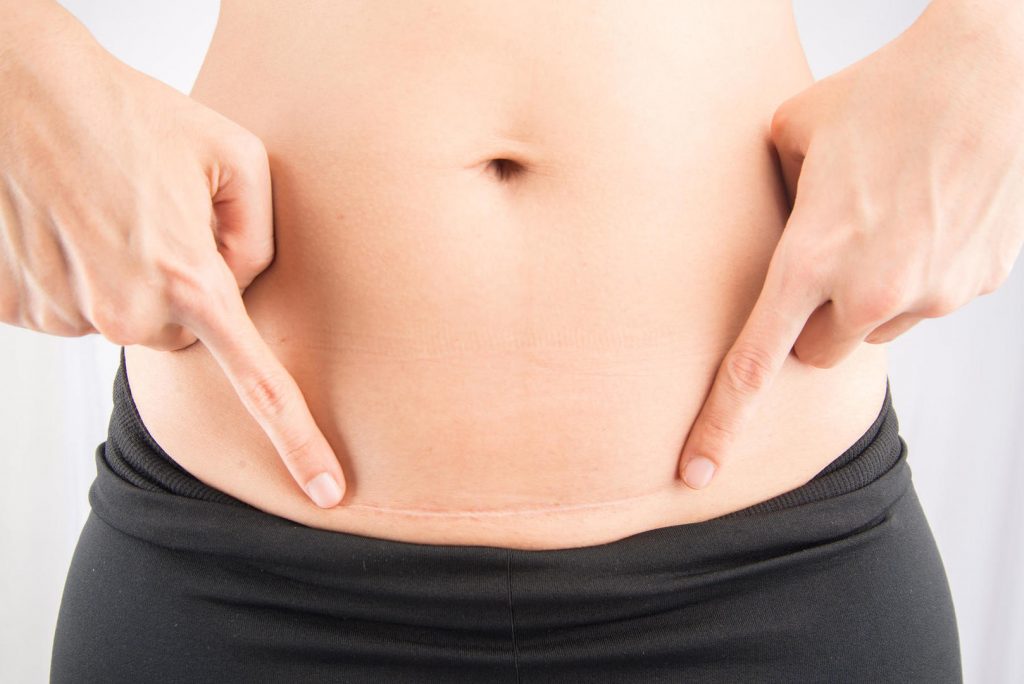A cesarean delivery — also known as a C-section — is surgical delivery of a baby. It involves one incision in the mother’s abdomen and another in the uterus.
The incision on the uterus is always closed with dissolvable stitches, but there are three ways doctors close your skin i.e. by Stapling, Stitching or Gluing. Most times, C-section scars heal properly. But sometimes your body’s healing process may go into an overdrive, which can lead to problems with scarring — especially if you’re younger (under 30) and have darker skin. The issues that could crop up include:
- A keloid is when the scar tissue has extended beyond the original boundaries of the wound, resulting in lump formation of the scar tissue present around the incision.
- A hypertrophic scar is usually a thicker, firmer and more raised scar — but unlike a keloid, it stays within the borders of its original incision line.
Read More: 11 Side Effects Of C-section No One Told You About
A Guide for C-Section Scar
To help a C-Section Incision Heal, following these common-sense tips will help your C-section scar to heal better:
- Keep it clean: Once a day, let water drip down the wound, no need to waterproof it but, avoid vigorous scrubbing. Lastly gently pat the area dry with a clean towel.
- Some doctors say it’s okay to apply antibiotic topical agents or petroleum jellies and to cover the wound; others say it’s better to apply nothing and leave the wound uncovered.
- Air it out as air promotes healing in skin injuries, so expose your scar whenever possible.
- Keep your appointments: If your incision was closed with stitches which have not dissolved, go to your follow-up appointments so your doctor can remove them. Leaving the stitches in for longer duration can lead to a funky-looking scar.
- Hold off on exercise and take it easy so as to allow the scars to heal. So avoid bending or twisting your body or picking up heavy objects.
- Get moving: Increased blood flow, in fact, helps healing. So as soon as you feel do try and take a stroll around.
Read More: 11 Reasons you might have a C-section Delivery
How to Minimize Scarring
By about two weeks, the scar should look and feel better. Though, it can take anywhere from six weeks to three months. Although the scar will fade on its own over time, a few simple tricks and tips can help improve its appearance:
- Silicone sheeting: Can be bought as small sheets over the counter. Some research has shown that it may help soften and flatten scars. Silicone sheeting can work its magic three or four weeks after your C-section (ask your doctor).
- Silicone gels and creams serve the purpose similar as silicone sheets. But again, always ask your doctor before trying any treatment for your scar.
- Limit sun exposure: Sunlight can cause the scar to be pigmented and noticeable.
Scar Treatment Options
While there are no ways to literally erase the scar, there are a few other options that can improve its look and feel:
Non-surgical procedures
- Laser therapy: Some lasers help removing discoloration or to soften its texture.
- Steroid injections: For aggressive scars (formed keloids or become hypertrophic), an injection of a steroid can reduce inflammation and flatten the scar so it is less noticeable.
Read More: 7 Ways to Speed Up the Recovery from a Caesarean Delivery
Surgical procedures
Doctors generally won’t do anything before 6 to 12 months after a C-section as its appearance may improve eventually. If still interested in surgical options, then talk to your doctor about the following options could work for you:
- Scar revision: Here the surgeon removes the skin around scar completely and then, sutures the new wound — leaving a thinner and a less visible scar. A scar revision may help if the C-section scar is wide, has thickened, if has formed a keloid or hypertrophic scar, or if you simply don’t like it and want something less noticeable.
- Tummy tuck: If you have excess loose skin over the tummy, an abdominoplasty might be worth considering. In the procedure, the surgeon cuts away extra fat and skin (including the C-section scar) and carefully stitches the incision together. It isn’t a good choice if the scar is small, since a tummy tuck scar is typically longer. But if your scar really is bother full (is large, discolored, raised, etc.) a tummy tuck could be right for you.
Read More: Bleeding after C section -What is Normal and What’s not
When to See Your Doctor?
Your doctor will give you recommendations for home care after the surgery and will even encourage you. Still occurrence of any of the following symptoms, do contact your doctor immediately:
- If there is redness, swelling or both in the incision or skin surrounding it.
- Fever higher than 100.4 F
- Oozing or drainage from the incision site
- Foul smell from the area
- The wound has turned hard or there is increasing pain around the wound
- Pain or tenderness in a specific spot of the incision (pinpointing a specific spot)
- Your incision splits open
Read More: 7 Foods that Help your Body Heal after giving Birth













